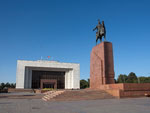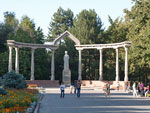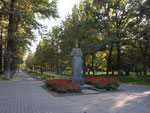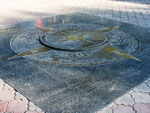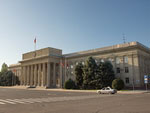Bishkek
Bishkek, the capital of the Republic of Kyrgyzstan, with a population of about 1 million, located in the Chui valley at the northern foot of the Kyrgyz Ala-Too on an inclined plain, at an altitude of 700-900 meters above sea level.
Its progenitrix was a fortress of Pishpek that appeared in 1825 – a fortification to protect the caravan routes running from Tashkent across the Chui valley to Issyk-Kul Lake.
After the battle with the Russian imperial troops and Kokand conquerors this fortification was destroyed and became part of the marginal lands of the Russian Empire. In 1897 the Pishpek population listed only 6,600 inhabitants. Pre-revolutionary Pishpek was more like a dusty village of mud houses. With the advent of Soviet rule, the city became rapidly developing. In 1926 he was renamed in honor of the revolutionary and military leader Mikhail Frunze who was born here. In 1991 the city got back its old name in the new interpretation - Bishkek. According to experts, "bishkek" means a stick for beating koumiss - the national drink of sour mare's milk.
Its progenitrix was a fortress of Pishpek that appeared in 1825 – a fortification to protect the caravan routes running from Tashkent across the Chui valley to Issyk-Kul Lake.
After the battle with the Russian imperial troops and Kokand conquerors this fortification was destroyed and became part of the marginal lands of the Russian Empire. In 1897 the Pishpek population listed only 6,600 inhabitants. Pre-revolutionary Pishpek was more like a dusty village of mud houses. With the advent of Soviet rule, the city became rapidly developing. In 1926 he was renamed in honor of the revolutionary and military leader Mikhail Frunze who was born here. In 1991 the city got back its old name in the new interpretation - Bishkek. According to experts, "bishkek" means a stick for beating koumiss - the national drink of sour mare's milk.
Bishkek - one of the major cities of Central Asia and the largest city in Kyrgyzstan with a population of over 800,000 people, the multinational city with over 80 nationalities. The main language of international communication is Russian.
The city has many places for recreation. There are several major museums, the most interesting of which is the Historical Museum, the Museum of Fine Arts, Museum named after M.V. Frunze. Downtown is flecked with posters Opera and Ballet Theatre, Russian and Kyrgyz Drama theaters, Bishkek City Drama Theatre, State Philharmony named after T. Satylganov.
It kept a lot of places reminding of the city history. Especially the centre is heavily influenced by the Soviets, and you can enjoy quite a number of typical soviet-style architecture (Philharmonia – concert hall, government building, Historic Museum, Monument for the Great War of the Native Country) but also modern monuments pointing out the traditional Kyrgyz culture (Monument of Manas, Monument of Independence, as well as many statues of Akyns, manaschi and local governors of different periods). It is interesting to note that Bishkek is the only city in Central Asia, where there is a monument to Lenin on the Central Square. Bishkek remembers its history and is pleased to tell it to anyone who wants to visit the small but cozy capital. Also, the city is famous being one of the greenest in the world, due to its countless parks and avenues, which make the town a nice place to live also in the heat of the summer.
The city has many places for recreation. There are several major museums, the most interesting of which is the Historical Museum, the Museum of Fine Arts, Museum named after M.V. Frunze. Downtown is flecked with posters Opera and Ballet Theatre, Russian and Kyrgyz Drama theaters, Bishkek City Drama Theatre, State Philharmony named after T. Satylganov.
It kept a lot of places reminding of the city history. Especially the centre is heavily influenced by the Soviets, and you can enjoy quite a number of typical soviet-style architecture (Philharmonia – concert hall, government building, Historic Museum, Monument for the Great War of the Native Country) but also modern monuments pointing out the traditional Kyrgyz culture (Monument of Manas, Monument of Independence, as well as many statues of Akyns, manaschi and local governors of different periods). It is interesting to note that Bishkek is the only city in Central Asia, where there is a monument to Lenin on the Central Square. Bishkek remembers its history and is pleased to tell it to anyone who wants to visit the small but cozy capital. Also, the city is famous being one of the greenest in the world, due to its countless parks and avenues, which make the town a nice place to live also in the heat of the summer.
Getting Around in Bishkek
Bishkek is an easy, inexpensive city to get around in. It is on a grid and relatively small capitol city, so navigating on foot or by car is easy. The mountains to the south are nearly always in view. Bishkek is wide and flat, and it's "center" is regarded as an interestingly large percentage of the overall city, usually including the area of Sovietskaya to Manas several blocks on either side of Chui. Public transportation (mini-buses and trolleybuses) usually runs from 5:30 or 6:00 in the morning till 9:00 or 9:30 at night.
Foot
One can cover a large part of Bishkek on foot in under an hour. It is relatively easy to get a bearing even if one isn't familiar with the city. However, hazards exist: Pedestrians are not given the "right-of-way" by cars as they usually are in other parts of the world, unmarked potholes, ditches and uncovered manholes are frequent, streets are poorly lit at night and violent crime relating to drunkenness happens. Travelers are advised to visit the Alpine Zone's page on "safety" - especially concerning foot travel at night. Westerners are picked out by locals nearly instantly. In general, people are friendly but unapologetically curious.
Foot
One can cover a large part of Bishkek on foot in under an hour. It is relatively easy to get a bearing even if one isn't familiar with the city. However, hazards exist: Pedestrians are not given the "right-of-way" by cars as they usually are in other parts of the world, unmarked potholes, ditches and uncovered manholes are frequent, streets are poorly lit at night and violent crime relating to drunkenness happens. Travelers are advised to visit the Alpine Zone's page on "safety" - especially concerning foot travel at night. Westerners are picked out by locals nearly instantly. In general, people are friendly but unapologetically curious.
Taxis
Taxis are readily available and cheap. Official taxis are marked but most people don't have a problem getting in the unofficial ones, which may or may not have a removable taxi sign on the roof. As a rule of thumb 70-100 som is a basic price for a short ride from one part of the city to another, but it might cost anywhere from 70 to 200 soms depending on distance, time of day, venue and your charm.
Taxis are readily available and cheap. Official taxis are marked but most people don't have a problem getting in the unofficial ones, which may or may not have a removable taxi sign on the roof. As a rule of thumb 70-100 som is a basic price for a short ride from one part of the city to another, but it might cost anywhere from 70 to 200 soms depending on distance, time of day, venue and your charm.
It is best to give a landmark that is close to your destination, and when going to restaurants, mentioning the intersection of two streets (like Moskovskaya-Razzakova) is better than saying Navigator Bar. The drivers might be tempted to charge you more money if they figure you've got it. You will definitely have to bargain. Make sure the driver isn't drunk and agree on a price before getting in. You may or may not be supplied with a seatbelt - and can expect an heart-felt protest if you try to find one.
Additionally there is a more professional, standard priced but more expensive "Super Taxi." Super Taxi is the most reliable way to get somewhere. Order one phone (dial 152), tell them your location and destination and they will pick you up in 10-20 minutes. Fares within the city start at 90 soms. If reliability, safety and not haggling is your priority Super Taxi is the best option.
Additionally there is a more professional, standard priced but more expensive "Super Taxi." Super Taxi is the most reliable way to get somewhere. Order one phone (dial 152), tell them your location and destination and they will pick you up in 10-20 minutes. Fares within the city start at 90 soms. If reliability, safety and not haggling is your priority Super Taxi is the best option.
Other official taxis in Bishkek
Mini-buses ("Marshrutki")
Marshrutki are the hundreds of VW, Mercedes and other vans driving in all different directions with numbered signs. Marshrutki are cheap (8 soms in Bishkek, 6 soms in Osh) and go just about anywhere, but the trick is figuring out which one is going where you need to.
Flag a passing Marshrutka by sticking your arm and hand out parallel to the ground, hop in and pay 8 soms upon entrance (in the southern part of the country pay up exiting). Marshrutka etiquette is that passengers farther from their stop should move to the back, young men and boys should give their seats to older folks (especially women), and one should take care not to step on or otherwise insult other passengers with their feet.
Marshrutki are the hundreds of VW, Mercedes and other vans driving in all different directions with numbered signs. Marshrutki are cheap (8 soms in Bishkek, 6 soms in Osh) and go just about anywhere, but the trick is figuring out which one is going where you need to.
Flag a passing Marshrutka by sticking your arm and hand out parallel to the ground, hop in and pay 8 soms upon entrance (in the southern part of the country pay up exiting). Marshrutka etiquette is that passengers farther from their stop should move to the back, young men and boys should give their seats to older folks (especially women), and one should take care not to step on or otherwise insult other passengers with their feet.
Marshrutki can become very, very crowded and drivers, understandably, are not known for their customer service with confused tourists. Many tourists decide to forego Marshrutki, opting instead for taxis. The following two pieces of advice can be given for new riders:
1. Along Chui, the vast majority of Marshrutki are commuting from Osh Bazaar to TsUM and say so relatively prominently on their front sign (in Cryllic script). This route will take you within blocks of a large part of Bishkek.
2. At a bus stop, ask a local person what number Marshrutka is heading where you need to go, hop in, pay the driver, and say "asta-naveetsya" when you want to stop.
1. Along Chui, the vast majority of Marshrutki are commuting from Osh Bazaar to TsUM and say so relatively prominently on their front sign (in Cryllic script). This route will take you within blocks of a large part of Bishkek.
2. At a bus stop, ask a local person what number Marshrutka is heading where you need to go, hop in, pay the driver, and say "asta-naveetsya" when you want to stop.
Trolleybuses
Trolleybuses are the big electric busses. The are slow, dilapidated and their electric rods frequently become disconnected from the overhead lines forcing a squealing stop. Enter from the back and pay 5 soms fare to the driver in the front upon exiting. Those who can afford it avoid trolleybuses. The best advice for trolleybuses is to stay well out of their way (and especially the path of their air horn).
Silk Road & Central Asia
Caucasus Travel

